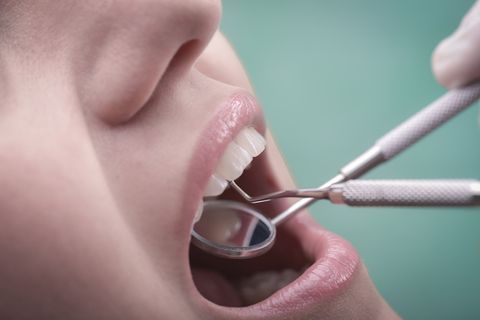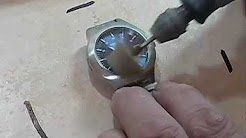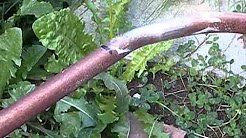I believe the best way to learn the process of restoring glass would be to watch my YouTube videos.
I will therefore use this page to describe the materials used, why these are the correct materials to use and to compare them to other materials.
All of the information given on this website result from my own research, experimentation and restoration over a period of 35 years.

TOOTHPASTE
I have to start with toothpaste. I have lost count of the number of times some smart person has said “no need for all that, you can use toothpaste to remove scratches from glass”.
Glass is harder than tooth enamel therefore if toothpaste was able to remove the surface layers of glass, which is part of the restoration process, then all those good boys and girls who brush their teeth every day would soon have no teeth left.
Toothpaste will however have limited success for very light scratches on some acrylics.
The process of successfully removing deep scratches and chips from glass involves 3 stages.
GRINDING – SMOOTHING - POLISHING
--------------------------------------------
When choosing the correct materials to use on each stage there are 3 main criteria to consider.
PARTICLE HARDNESS – PARTICLE SIZE – PARTICLE SHAPE
GRINDING STAGE
The grinding process involves removing the glass surface in a controlled way.
SILICON CARBIDE
Silicon Carbide ticks all the boxes with regards to particle hardness, size and shape.
Due to the particle shape the chips produced are wide and shallow making them easier to deal with in the next stage.
DIAMOND FILE
Diamond files tick the boxes for particle hardness and size but do not have the ideal shape leaving narrow "V" shaped chips that are harder to deal with.
Diamond files can also be used during the process for removal of scratches from sapphire watch crystals.
DIAMOND PASTE
I have experimented with diamond paste to see if I could improve on this process however, apart from the fact that the majority of paste is oil based thus the problems of heat control and lack of friction, I discovered that the grain shape was far from ideal. We need to bear in mind that diamonds, in their natural state, do not have facets these are created by the jewellers. Under magnification I found that the diamond particles tend to be fairly flat lozenge/cushion shaped with sharp ends and, nature being nature even in the microscopic world, these tend to lay flat with the
business ends that we need unable to make contact with the surface.
SMOOTHING STAGE
This is the most crucial stage as this is where we make sure the grinding marks are all removed before polishing.
This is the stage that gave me the biggest headache and took the longest to resolve, back then the information was pretty much as it is today, a wealth of incorrect information and hearsay but very little from those who have taken the time to research the subject.
After several years of experimentation I developed a formula in three different grades GPP01(course) – GPP02 (medium) – GPP03 (fine) and these are the powders I use in my videos.
Glass Polishing Powder
I am often asked why I use different grades of polishing powder.
Each grade was produced in order to overcome specific situations encountered during my time restoring glass.
Every glass producer has a different registered formula, this formula not only differs between producers but each producer will have many different formulas depending on which properties are required for the end product. There are also several methods used to create the end product, blown, blow moulded, pressed etc., each of these methods combined with the various formulas will produce many differing surface textures. In order to restore glass successfully we need to be able to replicate the various surfaces as near as possible to the original and for this we need a variety of grades and materials.
POLISHING STAGE
CERIUM OXIDE
A single grain of cerium oxide when viewed through a microscope will reveal a cluster of small rounded nodules. The purpose of cerium oxide is to rub the glass surface, in a similar way that ball bearings can be used to polish steel, therefore virtually no glass is removed during the process.
I recently read a report on the web by a researcher who found that at a high temperature the grains of cerium oxide would split and develop sharp edged crevices. The conclusion put forward suggested that these crevices were the reason cerium oxide worked. The main
flaw with this conclusion is that by
allowing the cerium to get to a temperature high enough for the grains to split would mean that the glass surface would be that temperature too which is
an absolute NO!!! Temperature control is crucial.
It is not the job? of cerium oxide to remove layers of glass, there are other materials that are far better suited for this purpose, it is purely intended as a final polish nothing more.
DIAMOND PASTE
Please don't be fooled into assuming that because it contains diamond it must be the best product for the task.
As I mentioned earlier I have experimented with diamond paste. I purchased a variety of grades from a couple of eBay sellers and spent many hours trying to polish scratches from glass, acrylic and sapphire watch crystals. After giving the products what I believe to be a fair trial the net result was 0 scratches removed, in fact I saw no discernable difference. To be honest
during the whole process I had the feeling that someone had forgotten to put the diamond in. LOL.
I then purchased a rather expensive water based diamond paste that guaranteed a good diamond content (not from eBay). This gave improved results, no scratches were removed but it did polish the surfaces albeit no better than the materials I already used. The one advantage was that using this paste I did polish the surface of
a sapphire watch crystal, which is something cerium oxide will not do.

SAPPHIRE WATCH CRYSTAL
It is highly unlikely that you will scratch a sapphire watch crystal as it is a very hard material and there are very few materials in everyday use that would be capable of damaging it. Before attempting restoration please look very closely at the scratch as there is every possibility that the surface is not damaged and that the sapphire has damaged the other material and that material has left a thin deposit onto the surface of the sapphire. If this is the case then just treat the same as a non intrusive scratch on glass.


